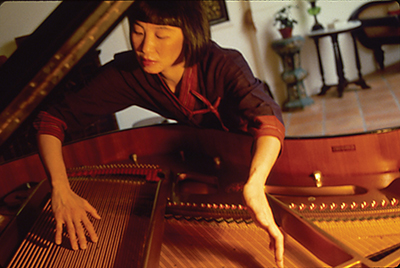Margaret Leng Tan at the National Gallery of Art
Margaret Leng Tan — the formidable doyenne of the avant-garde piano — has built a career on upending tradition, pushing her instrument into fresh, no-holds-barred sonic worlds. That’s led her into collaborations with some of the most pathbreaking composers in the country, and in a remarkable program on Sunday at the National Gallery of Art, Tan explored some of the innovations that have transformed the piano over the past century — concluding with the world premiere of George Crumb’s “Metamorphoses, Book 1,” a striking new work from a composer who, at 87, shows no sign of slowing down.
 Margaret Leng TanTan opened the afternoon with John Cage’s “The Perilous Night,” a 1944 work for “prepared piano” — an instrument created by inserting bits of metal, felt and rubber between the strings, transforming it into a sort of percussion orchestra. It’s a nocturnal work full of shadows and dread, and Tan played it with the restless, aching mystery of a dream. Or, perhaps, of a sleepless night: Cage, who was leaving his wife for the choreographer Merce Cunningham at the time, once said the work arose from “the terror that comes to one when love becomes unhappy.”
Margaret Leng TanTan opened the afternoon with John Cage’s “The Perilous Night,” a 1944 work for “prepared piano” — an instrument created by inserting bits of metal, felt and rubber between the strings, transforming it into a sort of percussion orchestra. It’s a nocturnal work full of shadows and dread, and Tan played it with the restless, aching mystery of a dream. Or, perhaps, of a sleepless night: Cage, who was leaving his wife for the choreographer Merce Cunningham at the time, once said the work arose from “the terror that comes to one when love becomes unhappy.”
Four short and evocative works by the influential composer Henry Cowell — who, in the early 20th Century, brought fists and forearms to the piano — followed, in an exuberantly physical performance by Tan, who wrapped herself over the keyboard to create massive tone clusters, and plunged inside to brush the open strings.
But the highlight of the afternoon was the Crumb premiere, a ten-part piano cycle written for Tan that, like Mussorgsky’s well-known “Pictures at an Exhibition,” transforms a series of artworks into music. Crumb’s always-colorful imagination and palette of sensual techniques were on full display, from the darting, shimmering gestures of Paul Klee’s “The Goldfish,” to the brooding melancholy of van Gogh’s “Wheatfield with Crows” (in which Tan showed her finely-honed cawing skills), to the galloping explosiveness of Kandinsky’s “The Blue Rider.”
But these weren’t mere clever tone-paintings — “Metamorphoses” felt intensely probing and often incantatory, as if conjuring up whole new worlds from the dark, elusive depths of the paintings. Tan played through them as if the fate of the world depended on it, and navigated the battery of instruments (amplified piano, woodblocks, toy piano, wind chimes, red clown nose) with extraordinary focus — winning a sustained standing ovation for herself and for the composer, who was in attendance.


Reader Comments